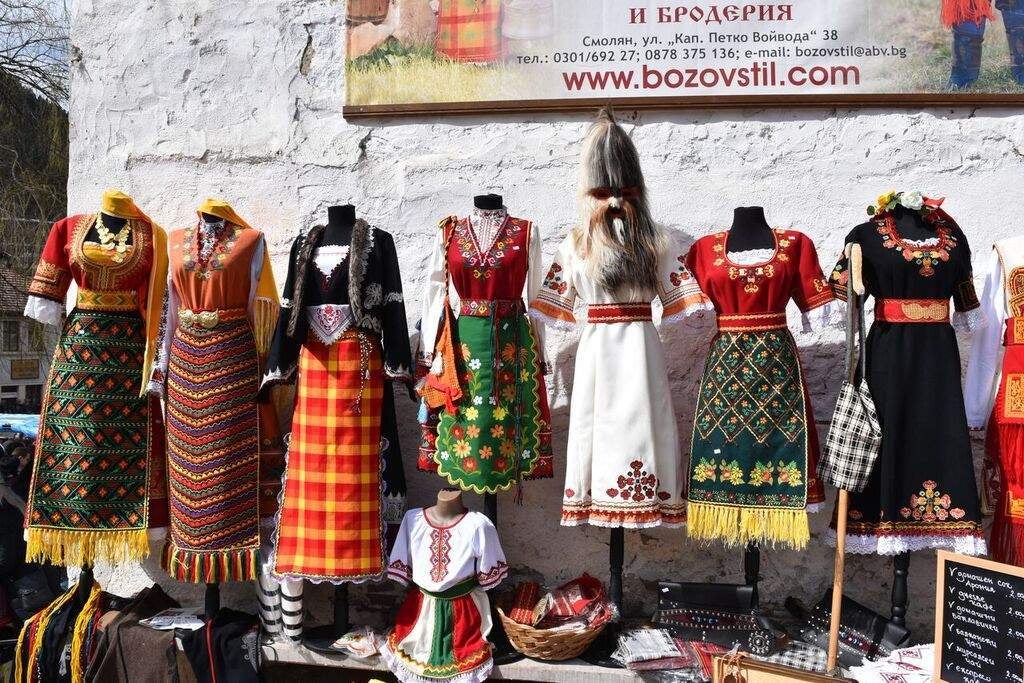
The mountains of southern Bulgaria are home to one of Europe’s great areas of historic interest — and yet the region remains blissfully unspoilt by tourism, writes Teresa Levonian Cole.
The eagle owl, nesting somewhere outside my window, was silenced. Instead, the wind howled, as though trying to break in, and dawn arrived with thunderous clouds scudding over the Rhodope mountains. Granny March, as this capricious month is known in Bulgaria, was having one of her unpredictable fits of pique. But by the time breakfast arrived — a feast of farm-fresh cheeses, clotted yoghurts, local honeys, mountain-herb tea, and jam from petals of the famously fragrant rosa bulgarica — Granny March was smiling again, sunshine glittering on the snowy slopes. Small wonder that, for some 6,000 years, she has been fêted and propitiated with festivals to scare off the demons of winter and herald the bounty of spring.
My visit coincided with the highlight of the social calendar in Shiroka Laka. A traditional mountain village of wood-and-stone houses with projecting upper floors, it hosts the annual Kukeri Festival, in which revellers compete for the most fearsome outfit as they process through the streets to the main square. Here, dressed in bearskins and horned helmets, girded by enormous brass bells, they dance around a fire re-enacting none-too-subtle fertility rituals to the orchestra-drowning racket of clanging and gunshots. Wintery demons might be deterred, but villagers thronged around the square, hung out of windows and threatened the collapse of rickety balconies. I, the only foreigner, was packed among them, marvelling at a scene of unfettered bacchanalia.
The musicians had had a better time of it the night before, as part of a spectacular performance at the School of Traditional Music and Dance. Eviscerated goats, transformed into bagpipes (gaida), accompanied plangent songs about age-old Turkish atrocities; a fiendishly strung gudulka underpinned joyful courtship quadrilles, while Middle Eastern harmonies betrayed the country’s chequered history. Despite almost 500 years under the Ottoman yoke, Bulgarians cling proudly to their customs. This, after all, was the ancient heartland of Thrace, where Nietzschean conflict between Dionysus and Apollo was expressed through the tragic figure of Orpheus…
Bulgaria, I confess, had never featured on my bucket list. But from my vantage point at Villa Gella in the remote mountains, Alexander Batchvarov was offering me a very different perspective on a country generally associated with nefarious Balkan practices and incoming package tourists in search of cheap sun and snow. Together with his family, Batchvarov, a London-based banker, has created what Marina Gratsos of villa specialist Carpe Diem calls ‘the loveliest house in Bulgaria’: a six-bedroom boutique hotel with picture windows and roaring fires that combines local hospitality and cuisine with discreet luxury and Western standards of service. Batchvarov’s address book, moreover, ensures no detail — from private helicopters to the country’s most knowledgeable guides — is overlooked. ‘If you come to Bulgaria,’ he had promised, ‘you will be amazed by a culture that turns accepted ideas on their heads.’
He was not wrong. Treasures unearthed at Varna, dating from the fifth millennium BC, had already indicated that the Thracians were the earliest creators of tooled gold, with instances of finest detail that cannot be replicated today. A warlike, mysterious people who lamented births and celebrated deaths, their elaborate, frescoed tombs — such as the 4th-century BC ones in Alexandrovo and Kazanlak — reveal sophisticated funerary rites and belief in the afterlife. That so many artefacts — magnificent rhytons, phiales and amphoras — related to wine (which the Thracians were notorious for consuming in undiluted form) points to their worship of Dionysus. ‘The oldest wines in the world were produced in these lands,’ says Batchvarov, whose family continues the tradition of viticulture at its Terra Tangra estate. ‘Dionysus was a Thracian God, worshipped in the name of Zagreus, before he was adopted by the Greeks.’
The search for the ancient temple of Dionysus which, Herodotus tells us, had been built by the Thracian Bessie tribe in the Rhodope mountains bore fruit in 2002 at the megalithic site of Perperikon. So we set off to one of the most significant recent archaeological finds in Europe, winding 130km through a mountainous landscape of limestone and conifer forests redolent of Bhutan. We passed meadows where horses grazed and cows idled, and signs indicating hidden hilltop monasteries; we skirted boulder-strewn rivers, photographed Roman bridges and reached the dystopian Communist town of Kardjali. Finally, 15km further, we arrived at our destination and climbed the sacred monumental staircase to the ruins of a multi-layered Palace-Sanctuary complex. Professor Nikolay Ovcharov, working on the site’s acropolis, waved us up to the summit.
Ovcharov has been excavating Perperikon since 2000, so far unearthing 10 per cent of the complex. By the 18th century BC (the late Bronze Age), this 7,000-year-old site was already an impressive Thracian religious centre, which later flourished under the Romans and Byzantines, to be destroyed by the Ottomans in 1362.
Temple tour
However, it was Dionysus’s rock-hewn temple that held me in thrall: open to the sky, with 3m-high altar for libations of wine, a nearby ritual wine press, pens for sacrificial animals, and a pit for the fire through which the oracle spoke. It is said to have prophesied Alexander the Great’s triumphs and foretold the greatness of the Roman Empire. ‘This oracle rivalled that of Apollo at Delphi,’ Ovcharov told me. ‘There is no doubt it is a temple to Dionysus — the only controversy is whether it is the one referred to by Herodotus. And all the evidence suggests it is.’
Ovcharov also excavated the tomb of Orpheus — erstwhile priest of Dionysus and founder of the Orphic cult — discovered in 2004 at nearby Tatul. ‘We know Orpheus was a historical character, a Thracian born near Shiroka Laka around the third millennium BC,’ argues historian and VIP guide Nadia Todorova of the figure I had thought a figment of poetic imagination, citing numerous references to his writings in the Classics. And it is in the person of this musician-prophet-healer that history and legend most poetically and confusingly intertwine. According to one version of the myth, transformed after the loss of Eurydice and his brush with Hades, Orpheus espoused the Apollonian qualities of restraint and order, turning his back on the orgiastic Dionysian rites. For this lèse majesté, he would be torn apart by the Maenads, his blood coalescing to form the rare Haberlea rhodopensis. The flower, endemic to the Bulgarian mountains, has its own mystery: it can be desiccated and ‘die’, only to revive, upon watering, up to three years later.
One site proved unexpectedly affecting: the cave through which Orpheus entered the Underworld to enchant Hades with his lyre and retrieve his beloved Eurydice. It seems to have been a fitting gateway to Hell: experiments have shown waters from the cave flow through a 25km subterranean labyrinth before emerging just metres away outside. No one who has sought to explore this enigma has emerged alive.
Devil’s Throat, as the cave is known, is experienced at its numinous best on a private visit, the vast, cavernous silence echoing with the roar of the River Trigrad cascading a sheer 60m into the Stygian depths. We skirted the waters, climbing 288 near-vertical steps towards the distant eye of light above, and stopped at a natural niche in the rock wall, into which spring water seeped, forming a little pool. Coins and icons had been placed all around, as though at a shrine. ‘Orpheus’s tears,’ explained my guide. ‘This is the point where he turned back to look at Eurydice, and lost her for ever.’
I had not expected a country of such natural beauty and cultural resonance. And if cultural tourism is in its infancy here, Batchvarov is its most passionate advocate. There are seven Bulgarian sites on the Unesco World Cultural Heritage list — which, along with Thracian monuments, include medieval churches and monasteries that harbour their own surprises. (Who knows that St Cyril created not the alphabet that bears his name, but the earlier Glagolitic alphabet, for the Bulgarian language? But that’s another story, mired in politics.) Perperikon is not even on the Unesco list, nor among the nine further monuments still pending approval. And with 17,000 known sites still to be excavated, we can be sure of further discoveries to provoke debate.
‘History is written by the victors,’ Todorova reminds me. But as Bulgaria begins to reclaim her heritage, that might be about to change.
Villa Gella is also available for private rentals








